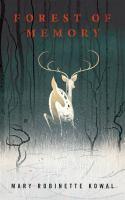
Have you ever questioned the reliability of your own memory? Do you wish you had a record of everything you encountered so you could refer to it later? What if having this capability meant that other people had access to information about you without your consent?
In Forest of Memory, Katya locates items of value and sells them to clients with information about the items’ origins. She looks at an object’s “wabi-sabi,” which is a Japanese term for beauty that is “imperfect, impermanent, and incomplete.” The items she finds for clients are not in pristine condition; they have evidence of use, and that is what attracts her clients.
Katya uses one of these items, an antique typewriter, to write her recollection of an experience she had in the forest. There are numerous mistakes in spelling and spacing as one would see on a document written using a typewriter, especially by someone who has not practiced this skill. The use of the typewriter is a stark contrast to the advanced technology mentioned throughout the story. At times, the mistakes can be distracting from the content of the book.
When she loses contact with her Artificial Intelligence system, Lizzie, she is alone in the forest with a strange man, whom she has witnessed shooting deer. She is very dependent on Lizzie, and without access to her AI, she is at a disadvantage when the man has information about her, but she has no idea who he is. As they spend a few days together, Katya tries to solve the mystery of who this man is, who his bosses are, and what they are doing with the deer and her. In the end, she has more questions than answers, and she begins to wonder how accurate her memory is, especially since she does not have her experiences backed-up online to confirm her theories about what transpired in the forest.
Many reviewers found the ending unsatisfying, which is understandable. I think the author purposefully did not answer questions that were raised. Katya narrates the book, so the audience only receives information she remembers, which leaves gaps in the story. This story has its own wabi-sabi, in that it is imperfect and incomplete.
